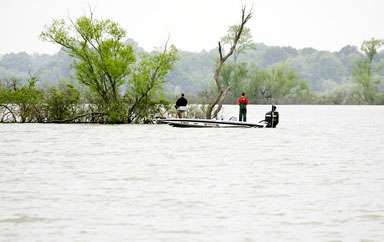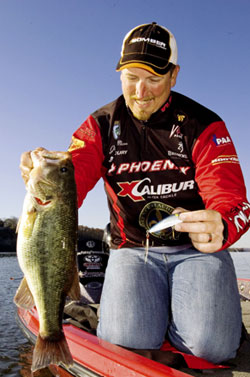
Wheeler Lake stretches for 60 miles between two of Alabama’s most renowned Tennessee River bass reservoirs. To the west of the Wheeler Dam lies Pickwick Lake. Guntersville extends east from the Guntersville Dam.
Wheeler has long played second fiddle to Pickwick and Guntersville because its bass fishery paled by comparison. The Alabama Bass Anglers Information Team (BAIT), ranked Wheeler near the bottom of other Alabama reservoirs. It produced good numbers of 12- to 15-inch bass, but fish heavier than 5 pounds were scarce.
The 2012 BAIT report was a shocker. Wheeler had leapfrogged from the bottom of the standings to No. 2. Today, 5-pound bass are caught here as frequently as in the early 1990s when Wheeler was in its heyday.
At 67,100 acres, Wheeler is Alabama’s second largest reservoir. From the Guntersville Dam, it flows west as a run-of-the-river reservoir past Huntsville and begins to spread out near Decatur. This midsection is embellished with extensive stump flats and creek channels. Farther down the lake you’ll find steep rocky banks and long points.
The varied habitat supports largemouth, smallmouth and spotted bass, with largemouth being the most sought after.
LARGEMOUTH IN THE BUSHES
Wheeler is drawn down 6 feet for winter pool, and April 15 is typically the day the lake comes up to full pool, points out noted bass guide Jimmy Mason.
“The largemouth move shallow as the water comes up,” Mason says. “The bass here wait until that happens before they spawn.”
This is when Mason and his clients blitz flooded buckbrush and other cover in water less than 3 feet deep. Flooded bushes are more prominent from Spring Creek to just above Decatur.
“There aren’t as many bushes on the lower end, but there are plenty of laydowns and boat docks there that hold bass in April,” Mason says.
The most productive bushes lie in slightly deeper water. They are typically point bushes, isolated bushes and bushes on the edge of a creek channel or drain.
“It’s critical that you fish those key bushes several times a day,” Mason says. “They constantly replenish because waves of spawners move in and out throughout the month of April.”
Flippin’ a Yum F2 Mighty Bug into the bushes keeps Mason and his clients in touch with Wheeler’s heavyweight bass. Mason rigs this soft plastic bait with a stout 4/0 hook, a 5/16-ounce bullet sinker and 20-pound Vicious Fluorocarbon line.
Another deadly option is swimming a white 1/4- or 3/8-ounce Booyah Boo Jig with a white silver flake Yum F2 Craw Chunk tight to bushes and other shallow cover. Mason recommends 65-pound Vicious Braid for this tactic.
“Later in April, you can catch fry guarders by working a Rebel Pop-R around the bushes,” Mason adds.
SMALLMOUTH ON THE ROCKS
April is also a prime month at Wheeler for hefty smallmouth bass. The brown ones spawn on rocky bluffs, which start south of Decatur and continue toward the Wheeler Dam. Mason targets what he calls “busy bluffs.”
“Look for bluffs that have staggered stair-step shelves, lots of cracks and crevices and broken rock and gravel,” Mason says. “That’s what the smallmouth spawn on.”
The bass typically spawn 5 to 10 feet deep, which is deeper than you can see them at Wheeler. Mason picks them off by blind casting a 6-inch green pumpkin Yum F2 Mighty Worm rigged weedless on a 3/16-ounce Booyah Big Show Football Shaky Head jig.
He casts the jig close to the bank with a spinning outfit and 8-pound fluorocarbon line. After the jig touches bottom, Mason slowly drags it off one rocky step and lets it sink straight down to the next one.
“The best bluffs are where you’re still in 6 or 7 feet of water after three or four pulls,” Mason says.
Twitching a 4.5-inch Smithwick Suspending Rattlin’ Rogue along bluff points and tailings also triggers strikes from Wheeler’s smallies in April. Mason does well with the foxy shad and clown colors on sunny days and the gold rogue color on cloudy and rainy days.
“The bass are active in April, so you don’t need long pauses in the retrieve,” Mason says. “I like a jerk-jerk-pause cadence with pauses of two to three seconds.”
MEET JIMMY MASON
Jimmy Mason resides in Rogersville, Ala., only five minutes from the Joe Wheeler State Park boat ramp. After fishing Wheeler Lake for 38 of his 42 years, and guiding here for 15 years, he knows these bass-rich waters intimately.
A successful tournament angler, Mason has competed in the Bassmaster Elite Series and now fishes Bassmaster Open tournaments between guide trips. He is also mapping Wheeler Lake for LakeMaster, the company that makes GPS map cards for Humminbird. “I’m learning places I never knew were there,” Mason says.
Mason and his wife, Casey, are blessed with a 6-week-old girl, Reagan, and an 18-month-old son, Wheeler, who was named after the lake. You can contact Mason’s guide service at www.jimmymasonbasspro.com.
GO HERE FIRST
Before you visit Wheeler or any Alabama reservoir, go to www.alabamabasstrail.org. Here you’ll find detailed information about nine lakes and two major river systems, including fishing locations, productive fishing patterns, local guides, campgrounds and where to stay.
For more information about fishing Wheeler Lake and accommodations, visit
www.decaturcvb.org.





